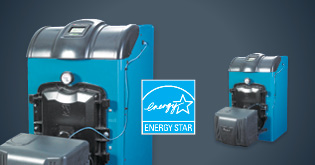
How your oil-fired heating system works.
 How your oil-fired heating system
works.
How your oil-fired heating system
works.
Oil-fired heating systems distribute heat in one of three ways: warm air through vents, hot water through baseboards, or steam through radiators.
Your thermostat senses that the room temperature has fallen below your thermostat setting and sends a signal to your heating system to provide heat for your home.
When your oil burner is engaged, heating oil travels from the tank to the burner by way of a pump where it becomes a fine mist mixed with air. The fuel/air mixture is then injected into the burner where it is ignited in the combustion chamber.

Heating system types.
Depending on the type of system you have, water-based or warm air, the system works differently to disperse heat throughout your home.
There are two main types of water-based systems: hot water systems and steam systems. Water is heated in either a cast iron or steel boiler before it is dispersed throughout your home.
In a hot water system, the heated water is circulated through radiators or baseboards.
In a steam system, the water turns to steam and rises through pipes to the radiators. In a warm air system, your furnace heats air. A blower then sends the heated air up through the ducts and out of vents in your floors or walls. The air gets drawn back to the furnace through a return duct and the cycle repeats.
Finally, the emissions from the combustion of fuel and air exit the system through a flue pipe that runs out of your home through the chimney.



.jpg?sfvrsn=f899b5b1_1)
.jpg?sfvrsn=4d57d9b7_3)